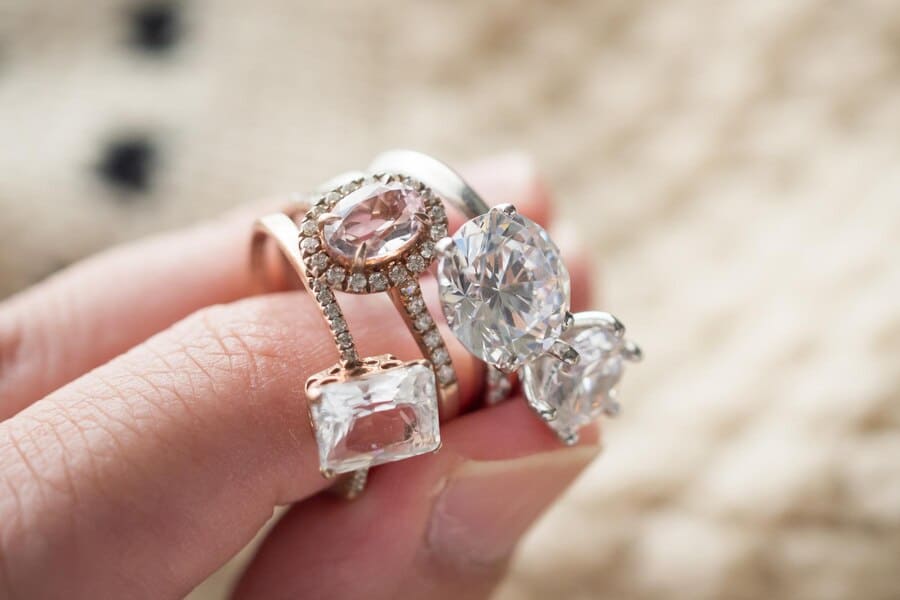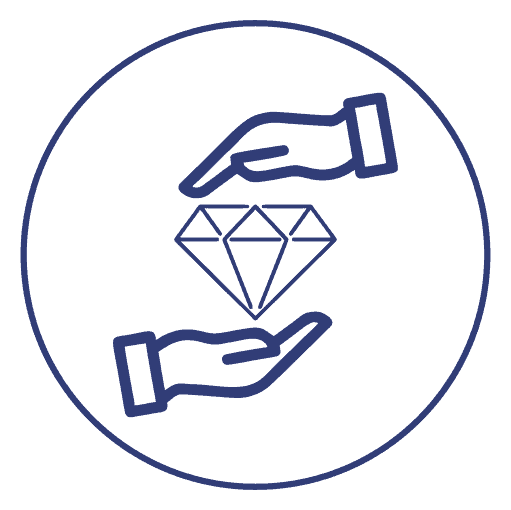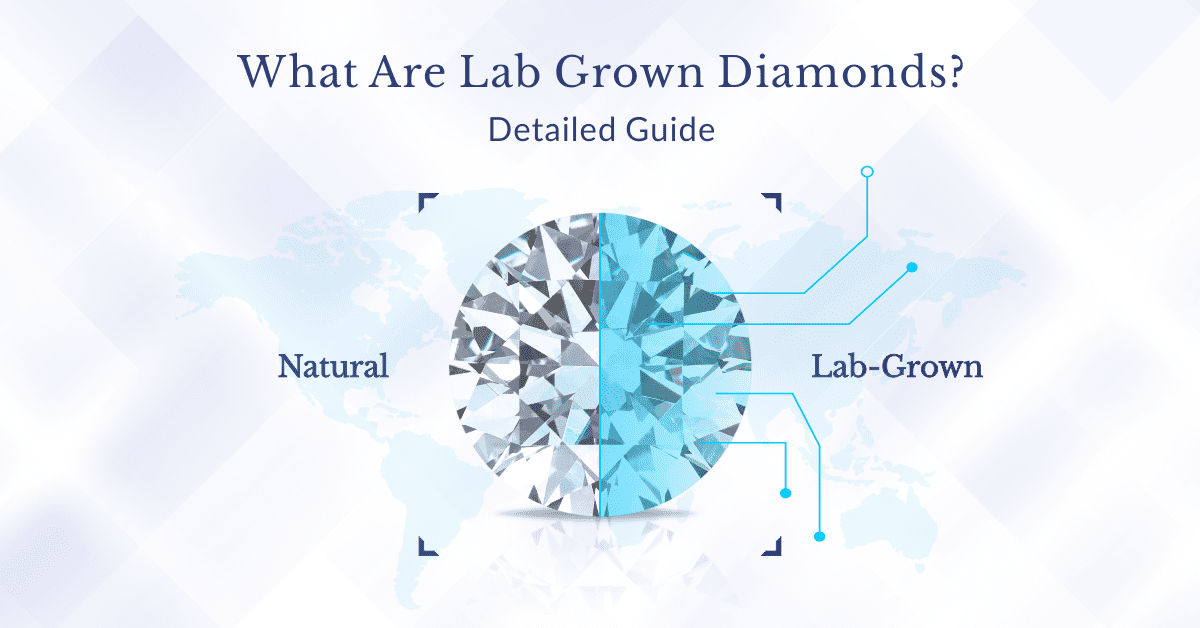Lab-Grown Diamond or lab-created diamond, as the name suggests, is a diamond grown in a laboratory. These diamonds are grown by recreating the same environment that fosters the development of natural diamonds beneath the earth’s crust. Advanced technological processes are used for the same.
High pressure and heat treatment are applied to develop lab-created diamonds. Like natural diamonds, even lab-grown diamonds consist of 100% carbon atoms arranged in the form of a diamond crystal structure. As these diamonds are made of the same material, i.e. carbon, they exhibit the same physical, chemical and optical characteristics as that of a naturally mined diamond.
Can Lab-Grown Diamonds Be Called As Real Diamonds?

Yes, lab-grown diamonds are real diamonds. Lab-grown diamonds have the same characteristics as real mined diamonds. They have the same crystal structure, sparkle, fire, and scintillation as that of a natural diamond. These diamonds are as durable as natural diamonds.
Even lab-created diamonds are becoming a prominent choice for engagement rings and other JEWELLERY gifts. These man-made diamonds are also graded and certified to equal standards as naturally mined diamonds.
How Are Lab-Grown Diamonds Made?

To better understand the process of formation of lab-grown diamonds, let’s first understand how natural diamonds are obtained from mother nature. The process is almost the same. It is just that the former is grown in a lab while the latter is naturally found in the earth’s crust.
The process of the formation of diamonds starts with carbon dioxide being buried hundreds of miles in the earth’s surface. This carbon dioxide is exposed to extreme heat and pressure conditions. As and when the volcano erupts, these diamonds come close to the surface of the earth in the form of volcanic eruptions.
Lab-grown diamonds are created by 2 processes – High-Pressure-High-temperature (HPHT) and Chemical Vapor Deposition (CVD).
A small diamond seed is placed into the carbon. This seed is processed using either of the 3 processes – belt press, cubic press, and the split sphere (BARS) press. The seeds are exposed to a temperature as high as 1500℃ and pressurised to 1.5 million pounds per square inch. At such an extreme temperature and pressure, the carbon melts to form a diamond. It is then cooled to form a pure diamond.
The diamond seed is then placed in a chamber. This chamber is filled with Methane and other gases that are compounds of carbon. The chamber is heated at a temperature of 800℃
The gases are ionised into plasma using microwave technology. This ionisation breaks the molecular bonds and pure carbon begins to crystallise and take the shape of the diamond seed.
Benefits of Lab-Grown Diamonds
1. Affordability

Lab-grown diamonds are affordable because of 2 reasons – the demand-supply gap and the process of manufacturing. Mining natural diamonds takes up a huge chunk of expense.
Since lab-grown diamonds do not go through the process of mining, the manufacturing cost is significantly low. Because of the shorter supply chain, lab-grown diamonds are 30-40% less expensive than their counterparts. This means that you can buy more quantities of lab-grown diamond in the same budget.
2. Eco-friendly Alternative

Mining has a severe effect on the environment. It can cause massive damage to the land and fossil fuels. Since lab-grown diamonds grow in the lab, they do not cause any damage to the environment and prove to be a sustainable choice.
Since these diamonds are grown in the lab using CVD and HPHT techniques, it is easier to keep up with the demand without compromising on quality.
3. Good Purity & Fewer Defects

Unlike mined diamonds, man-made diamonds do not have any dirt, and impurities ingrained in them. While diamonds beneath the earth grow under extreme conditions, lab-created diamonds grow in a controllable environment, having minimal defects in the crystal structure.
The top-notch purity of the lab-grown diamond makes it brighter, shinier, and better.
4. Ethical Sourcing

Incidents of diamond smuggling, injuries to mining labourers, deterioration of diamond quality, and discrepancies in diamond transactions are some of the many problems while obtaining natural diamonds. The manufacturing of lab-grown diamonds is hassle-free, safe and ethical.
Difference Between Lab-Grown Diamond and Natural Diamond
1. Durability

Both lab-grown diamonds and natural diamonds are made of carbon. Lab-grown diamonds also have a rating of 10 on the Mohs hardness scale.
When it comes to durability, both are equally durable. reasons – the demand-supply gap and the process of manufacturing. Mining natural diamonds takes up a huge chunk of expense. Since lab-grown diamonds do not go through the process of mining, the manufacturing cost is significantly low.
Because of the shorter supply chain, lab-grown diamonds are 30-40% less expensive than their counterparts. This means that you can buy more quantities of lab-grown diamond in the same budget.
2.Price

The price of lab-grown diamonds is comparatively lesser than those acquired from nature. This is because natural diamonds require mining and other procedures before being ready for cutting and polishing. But in the case of lab-grown diamonds, one eliminates the need for miners and distributors.
Another reason why the price varies is that natural diamonds are produced according to nature’s wishes. Thus, giving people the option of getting the rarest diamonds will naturally be highly expensive. But in the case of lab-grown diamonds, you can get them in abundance, so you limit the chances of it being rare.
3. Origin

Natural diamonds are mined from beneath the surface of the earth. With years of pressure and heat, the carbon solidifies to form diamonds.
On the other hand, lab-grown diamonds are grown in the lab through deposition techniques. Even though the process of cutting and polishing remains the same in this case, only the process of the formation of the diamond is different.
How Are lab-grown diamonds graded?
Lab-grown diamonds are graded in the same way as mined diamonds are. Just like real diamonds, lab-made diamonds will vary in their 4 C’s and quality and can range from poor to outstanding.
Our lab-grown diamond report is a thorough assessment of the lab-created diamond and is safeguarded by a security system that includes several layers of protection.. The entire process from start to finish is safe, secure and guaranteed to be fair.
WHAT ARE LAB-GROWN DIAMONDS - KEY TAKEAWAYS
- Lab-grown diamonds are real diamonds with the same physical, chemical, and visual characteristics as natural diamonds.
- Lab-grown diamonds are created using advanced techniques like high-pressure high-temperature (HPHT) and Chemical Vapor Deposition (CVD) that simulate the natural diamond formation process in a controlled environment.
- Benefits of Lab-Grown Diamonds: Lab-created diamonds offer affordability, eco-friendliness, good purity with fewer defects, and ethical sourcing.
- Lab-grown diamonds are equally durable as natural diamonds, but they are more affordable, have a different origin (created in a lab), and are more widely available.
- Lab-grown diamonds are graded using the same criteria as natural diamonds, assessing the 4 Cs and quality, ensuring transparency and security in the process.
Frequently Asked Questions (FAQs)
Yes. You can insure a lab-created diamond just like a natural diamond.
Yes. You get plenty of choices even for lab-grown diamonds as they are available in all colours and clarity.
No. Lab-grown diamonds do not become cloudy as they have higher durability and their chemical characteristics are the same as that of a natural diamond.
No. Both lab-created diamonds and natural diamonds are visually identical. Hence, a normal person cannot spot the difference between the two. The only way to spot a difference between lab-created diamonds and natural diamonds is through magnification. A professional gemologist uses magnification to figure out the nature of inclusions.
Yes. There is a good resale market for these diamonds so you can resell them at a similar value to what you would receive for a naturally mined diamond. However, buying a diamond is luxury shopping. Hence, it would be wrong to expect a profit on the resale of a diamond.
Yes. We do grade lab-grown diamonds using the latest technology and fair assessment techniques. An SGL grading is internationally accepted.
It takes 8-10 days to grow a 1-carat lab-grown diamond.

